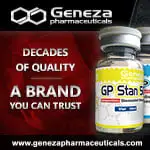b1ewsw32
New member
OK...excellent. So the CYP19 gene can never be affected by aromasin and therefore will always be able to synthesize more aromatase enzymes.Jenetic said:The first statement would make sense due to the fact that the CYP19 gene resposible for production of the P450 aromatase is unaffected, therefore it would not affect the production of the aromatase enzyme. A direct mutation of the CYP19 gene would be necessary for a loss in production to occur.
But to say that ERT would not be needed if the P450 aromatase was not in production whatsoever does not make much sense due to the fact that, in males, estrogens derive from circulating androgens. Aromatization of the C19 androgens, testosterone and androstenedione, to form estradiol and estrone, respectively, is the key step in estrogen biosynthesis, which is under the control of the aromatase enzyme.
As far as ERT is concerned, I agree as brianz failed to realize that despite having"normal" detectable e levels is not the issue as libido,lipid,bone and neurological problems can still ensue because estrogen levels are an individual matter and what's optimum may very from one person to another. It's just like free testosterone levels being within "normal limits" but it's usually low normal and the individual feels like shit. Once HRT brings patient to the higher normal parameters then psycological and physiological benefits become apperant.
This study came to mind.....
Role of oestrogen in male sexual behaviour: insights from the natural model of aromatase deficiency.
Carani C, Rochira V, Faustini-Fustini M, Balestrieri A, Granata AR.
Chair of Endocrinology, Department of Internal Medicine, University of Modena, Italy.
OBJECTIVE: In order to evaluate the role of oestrogens on human male sexual behaviour, the gender-identity, psychosexual orientation and sexual activity of a man with a congenital lack of oestradiol resulting from an inactivating mutation of the aromatase P450 gene was investigated. The psychosexual and sexual behavioural evaluations were performed before and during testosterone treatment and before oestradiol treatment, during three phases of different dosages of oestradiol treatment. DESIGN: The study was performed before (phase A) and during (phase B) testosterone enanthate treatment (250 mg i.m. every 10 days, for 6 months), during testosterone withdrawal (phase C), and during each of the following transdermal oestradiol treatments: 50 microg twice a week for 6 months (phase D); 25 microg twice a week for 9 months (phase E), and 12.5 microg twice a week for 9 months (phase F). MEASUREMENTS: Sexual behaviour was investigated by a sexological interview and by a 2-month self-reported daily diary performed during each phase of the protocol study. Furthermore, during each oestradiol treatment (phase C, D, E and F), a study of depression, anxiety trait and sexual behaviour was performed by the Beck Depression Inventory (BDI), the Spielberger Trait Anxiety Inventory (STAI) and the Golombok-Rust Inventory of Sexual Satisfaction (GRISS), respectively. Sexual orientation and gender-identity were evaluated by the BEM Sex Role Inventory (BSRI). Serum testosterone and oestradiol were measured during each phase of the study. RESULTS: Before oestradiol treatment (phase C), serum oestradiol was undetectable, while it rose to 356.1, 88.1 and 55.1 pmol/l during phases D, E and F, respectively. Before any oestradiol treatment, during phase D, phase E and phase F serum testosterone was 18.13, 0.72, 14.3 and 18.51 nmol/l, respectively. The patient's gender-identity as assessed by BSRI and by the sexological interview was clearly male. The psychosexual orientation evaluated by BSRI, by the sexological interview and by the analysis of the self-filled diary was heterosexual. Relevant modification of the patient's sexual behaviour occurred only during oestrogen treatment. This was more evident during both phase E and phase F, and concerned the behavioural parameters with an increase of libido, frequency of sexual intercourse, masturbation and erotic fantasies. A reduction of BDI and STAI scores was detected during the oestrogen phases. CONCLUSIONS: The study of the sexual behaviour in this man with aromatase deficiency suggests that oestrogens in humans do not affect gender-identity and sexual orientation but could have a role in male sexual activity.
B32


 Please Scroll Down to See Forums Below
Please Scroll Down to See Forums Below 












